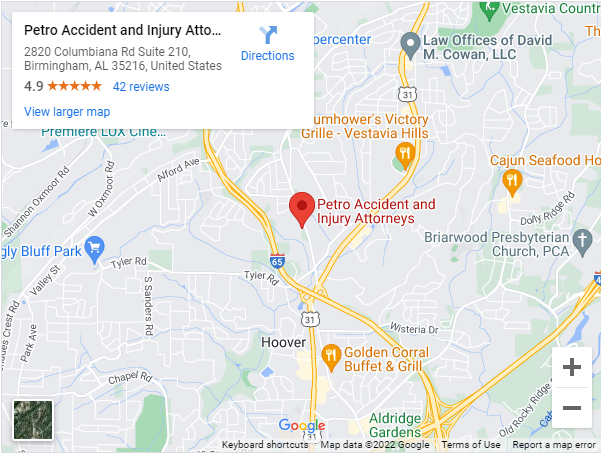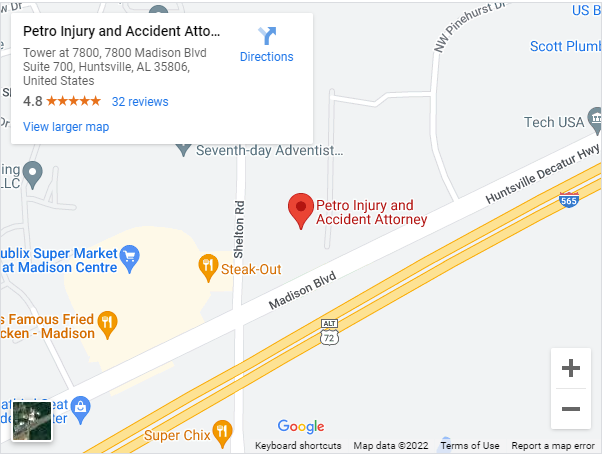Determining Fault in the Age of Autonomous Cars
How to determine self-driving car accident fault in Alabama? As self-driving cars become part of Alabama’s evolving transportation system, the question of liability in the event of an accident takes center stage.
A self-driving car accident refers to a collision or incident involving a vehicle equipped with autonomous or self-driving technology. These vehicles are designed to operate without direct human intervention, relying on a combination of sensors, cameras, radar, and artificial intelligence to navigate, make decisions, and respond to their surroundings.
Key Points:
- Self-driving cars, or autonomous vehicles, operate without direct human input, utilizing advanced technology for navigation.
- Self-driving car accidents can occur for various reasons, involving a complex interplay of factors.
- Types of self-driving car accidents include collisions with vehicles, pedestrians, or stationary objects.
- Causes of accidents may include sensor malfunctions, software glitches, human-driven vehicle interactions, adverse weather, and decision-making algorithm issues.
- Investigations involve analyzing data logs, sensor readings, and maintenance records to reconstruct events leading to the accident.
- Self-driving vehicles have automation levels ranging from Level 0 (no automation) to Level 5 (full automation).
- Liability in a self-driving car accident may involve manufacturers, technology providers, software developers, vehicle owners, maintenance providers, and more.
- Determining liability requires a comprehensive analysis of accident details, data retrieval, forensic analysis, and compliance assessments.
- Recoverable compensation may include medical expenses, lost wages, property damage, pain and suffering, emotional distress, and more.
- The statute of limitations for filing a personal injury lawsuit in Alabama is generally two years.
Self-driving car accidents can occur for various reasons, and determining liability in such incidents involves a complex interplay of factors. Understanding who bears responsibility in the aftermath of a self-driving car accident is crucial for both legal practitioners and the general public navigating the roads of Alabama.
Self-Driving Cars
Self-driving cars, also known as autonomous vehicles, are vehicles equipped with advanced technology and systems that allow them to operate without direct human input. These vehicles use a combination of sensors, cameras, radar, lidar, GPS, and sophisticated software to navigate, perceive their environment, and make real-time decisions.
The goal of self-driving cars is to enhance safety, reduce traffic congestion, and provide greater mobility for individuals, including those who may be unable to drive.
Self-Driving Car Accidents
A self-driving car accident refers to an incident involving a vehicle equipped with autonomous or self-driving technology. Despite the advancements in technology and the potential benefits of self-driving cars, accidents involving these vehicles can occur, often raising questions about the safety, liability, and regulatory aspects of autonomous driving.
Key points related to self-driving car accidents include:
Types of Accidents
Self-driving car accidents can take various forms, including collisions with other vehicles, pedestrians, or stationary objects. These accidents may result from malfunctions in the vehicle’s sensors, software errors, or challenges in navigating complex and dynamic environments.
Causes of Accidents
Accidents involving self-driving cars can be caused by a range of factors, including sensor malfunctions, software glitches, unexpected interactions with human-driven vehicles, adverse weather conditions, and issues with the vehicle’s decision-making algorithms.
Investigations and Data Analysis
When a self-driving car accident occurs, investigations typically involve analyzing data logs, sensor readings, and other relevant information to reconstruct the events leading up to the incident. This process aims to understand the sequence of actions taken by the autonomous system and identify any contributing factors.
As self-driving technology continues to advance, addressing the challenges associated with accidents is important to realizing the full potential of autonomous vehicles while ensuring the safety of road users.
Levels of Self-Driving Vehicle Automation
The levels of self-driving vehicle automation, as defined by the Society of Automotive Engineers (SAE) in the J3016 standard, categorize autonomous driving capabilities into six levels, ranging from Level 0 to Level 5. These levels represent a spectrum of increasing automation, describing the extent to which a vehicle can perform driving tasks without human intervention. Here is an overview of each level:
- Level 0 – No Automation: At Level 0, there is no automation, and the human driver is solely responsible for controlling the vehicle. This level may involve basic driver assistance features, such as warnings or momentary interventions, but the vehicle does not perform any driving tasks independently.
- Level 1 – Driver Assistance: Level 1 involves driver assistance features, where the vehicle can assist with either steering or acceleration/deceleration, but not both simultaneously. Common examples include adaptive cruise control or lane-keeping assistance.
- Level 2 – Partial Automation: At Level 2, the vehicle can simultaneously control both steering and acceleration/deceleration within certain conditions. However, the driver must remain engaged and monitor the driving environment, ready to take control when needed. Examples include advanced adaptive cruise control with lane-keeping assistance.
- Level 3 – Conditional Automation: Level 3 allows the vehicle to handle certain driving tasks autonomously under specific conditions, such as highway driving. In Level 3, the driver can disengage from active control but must be ready to intervene if the system requests assistance or encounters a situation it cannot handle.
- Level 4 – High Automation: At Level 4, the vehicle can perform most driving tasks autonomously within certain predefined conditions or geofenced areas. In these scenarios, the vehicle does not require constant driver monitoring. However, if the system encounters a situation it cannot handle, it may request driver intervention.
- Level 5 – Full Automation: Level 5 represents full automation, where the vehicle is capable of handling all driving tasks under all conditions without any human intervention. There is no need for a steering wheel, pedals, or a driver’s seat. Level 5 vehicles can operate autonomously in any environment and are designed to navigate complex urban and rural scenarios.
Who’s Liable in a Self-Driving Car Accident?
Liability in a self-driving car accident can involve various parties, and the determination of fault depends on the specific circumstances of the incident. The potential parties liable in a self-driving car accident may include:
Vehicle Manufacturer
The manufacturer of the self-driving vehicle may be held liable if the accident is caused by a defect in the vehicle’s design, manufacturing, or software. This could include issues with sensors, navigation systems, or other components.
Technology Provider
Companies or entities responsible for developing self-driving technology, including the software and algorithms guiding the vehicle, may bear liability if a failure in the technology contributes to the accident.
Software Developer
If the accident results from a software glitch, error, or failure, the entity responsible for developing the software used in the self-driving system could be held liable.
Vehicle Owner/Operator
In cases where the self-driving car requires human intervention or oversight, the owner or operator may share liability. This could include situations where the human driver failed to take control when required or ignored safety warnings.
Maintenance Providers
Entities responsible for the maintenance and upkeep of the self-driving vehicle might be liable if a failure in maintenance contributes to the accident.
Third-Party Integrators
In some cases, third-party companies responsible for integrating or modifying the self-driving technology into existing vehicles may share liability.
Road Infrastructure Authorities
If the accident is caused by issues with road infrastructure, such as poor signage, malfunctioning traffic signals, or inadequate road markings, the authorities responsible for maintaining the road may be implicated.
Other Drivers or Road Users
Liability may extend to other drivers, pedestrians, or cyclists involved in the accident. This could occur if their actions contributed to the collision, or if the self-driving car failed to respond appropriately to their presence.
Regulatory Compliance Entities
Entities responsible for ensuring that the self-driving car complies with relevant regulations may be liable if regulatory standards are not met.
Determining the liable party or parties in a self-driving car accident is a complex process that involves investigations into the specific factors contributing to the incident. Legal professionals, accident investigators, and experts in autonomous vehicle technology may all play roles in assessing liability.
How to Determine Liability in Self-Driving Car Crashes?
Determining liability in self-driving car accidents involves a comprehensive analysis of various factors to identify the party or parties responsible for the incident. Here are steps and considerations that may be involved in the process:
-
Accident Investigation
Conduct a thorough investigation into the details of the accident. This includes collecting evidence from the scene, examining damage to vehicles, and identifying any relevant road conditions or environmental factors.
-
Data Retrieval and Analysis
Retrieve and analyze data from the self-driving car’s sensors, cameras, and other monitoring systems. This data can provide insights into the vehicle’s actions leading up to and during the accident.
-
Forensic Analysis
Engage forensic experts to analyze the software and hardware components of the self-driving system. This includes examining the code, algorithms, and any potential malfunctions that may have contributed to the accident.
-
Review of Maintenance Records
Check maintenance records to ensure that the self-driving vehicle was properly serviced and that all components were functioning as intended. Negligence in maintenance could be a contributing factor.
-
Driver Interaction Logs
If human intervention is required in certain situations, review logs or records of the driver’s interactions with the vehicle. This can help determine if the driver followed guidelines and appropriately intervened when necessary.
-
Compliance with Regulations
Assess whether the self-driving car and its operators complied with relevant regulations. Failure to adhere to safety standards or testing requirements may impact liability.
-
Manufacturer and Technology Provider Analysis
Investigate the role of the vehicle manufacturer, technology provider, or software developer. Evaluate whether the accident resulted from a defect in the design, manufacturing, or software of the self-driving system.
-
Human Factors
Consider the actions of other parties involved, such as pedestrians, cyclists, or human drivers of other vehicles. Evaluate whether their actions contributed to the accident and if the self-driving car responded appropriately.
-
Witness Testimonies
Gather testimonies from witnesses who observed the accident. Their perspectives can provide valuable insights into the sequence of events and factors leading to the collision.
-
Expert Opinions
Consult with experts in autonomous vehicle technology, accident reconstruction, and relevant fields. Their expertise can help interpret data, identify technical issues, and provide opinions on liability.
-
Legal Consultation
Seek legal advice from a personal injury attorney familiar with autonomous vehicle regulations and liability issues. Legal professionals can assess the situation, provide guidance on potential liability, and help navigate the legal complexities.
The process of determining liability in self-driving car accidents may vary and different considerations may be factored in. Additionally, the landscape of autonomous vehicle technology and associated liability issues is continually evolving, so staying informed about the latest developments is crucial.
Can I Recover Compensation for My Injuries?
The compensation you may be able to recover after a self-driving car accident can cover various damages and losses resulting from the incident. Here are common types of compensation you might seek:
- Medical Expenses
- Lost Wages
- Property Damage
- Pain and Suffering
- Emotional Distress
- Loss of Consortium
- Disfigurement or Scarring
- Wrongful Death Damages
- Punitive Damages
The amount of compensation you can recover depends on various factors, and it’s challenging to provide a specific figure without knowing the details of your case. The value of your claim will be influenced by factors such as the extent of your injuries, the impact on your life, and the specific circumstances of the accident.
Is There a Time Limit in Filing a Claim?
In Alabama, the time limit within which you must file a lawsuit after a personal injury incident is governed by the statute of limitations. The statute of limitations sets a deadline for initiating legal action, and if you fail to file a lawsuit within this timeframe, you may lose the right to pursue your claim.
The statute of limitations for personal injury cases in Alabama is two years. This means that, in most cases, you have two years from the date of the self-driving accident or injury to file a lawsuit. However, it’s important to note that the specific details of your case may impact the applicable statute of limitations. Different types of cases and certain circumstances may have different deadlines, and there may be exceptions or factors that could extend or shorten the time limit.
Seek Legal Help From Our Self Driving Car Accident Attorney in Alabama Today!
Self-driving car accidents represent a new area in the legal landscape, necessitating a detailed understanding of technological, regulatory, and liability issues. If you are unfortunate enough to be involved in a self-driving automobile accident, taking preventative steps is critical.
From determining liability to seeking compensation, the process can be complex and challenging. Seeking the guidance of experienced legal professionals who understand the complexities of autonomous vehicle accidents is essential. Petro Accident and Injury Attorneys, with experience in personal injury cases, including those involving self-driving cars, stand ready to assist you through the legal complexities and advocate for your rights.
At Petro Accident and Injury Attorneys, our commitment goes beyond legal representation. We strive to be your partner in reclaiming control and seeking resolution after a self-driving car accident, truck wreck, motorcycle collision, or any other personal injury case. Give us a call today!




